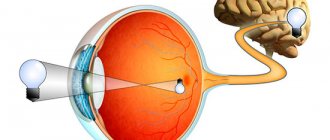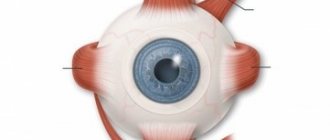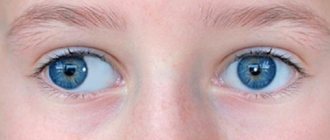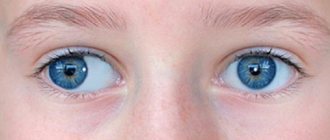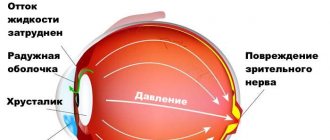Strabismus is a common ophthalmological disease that can develop at any age. Most often, the pathology is congenital or appears as a result of impaired refractive ability of the eyes. When making a diagnosis and determining the necessary therapy, one of the most important indicators is the Hirschberg strabismus angle.
Share
Tweet
Share
Cool
Send
Features of the development of strabismus
Strabismus (heterotropia) is an ophthalmological disease in which one or both eyes deviate directly from the central axis when looking. With this pathological condition, when looking at an object, the brain receives 2 different images that are not able to combine into a single image. To avoid double vision, the central nervous system excludes the image received from a squinting eye. This leads to the fact that the diseased organ of vision ceases to participate in the visual process, and amblyopia or lazy eye syndrome develops.
The causes of heterotropia can be very diverse: infectious processes, eye and head injuries, central nervous system pathologies, ophthalmological diseases, somatic pathologies and much more. Strabismus is accompanied by an external defect, the severity of which depends on the angle of deviation from the central axis. The disease also manifests itself with the following symptoms:
- diplopia;
- fast fatiguability;
- heaviness in the eyes;
- image overlay;
- reading difficulties;
- violation of depth perception and sense of volume.
If left untreated, strabismus leads to decreased visual acuity and can even lead to partial or complete blindness.
It is very important to diagnose the problem and take effective therapeutic measures as early as possible.
Types of strabismus
Congenital and acquired
Strabismus is extremely rarely congenital. If it develops in the first six months of life, it is called infantile. As a rule, the cause is genetic syndromes (for example, Down), hereditary strabismus, cerebral palsy or congenital eye defects (prematurity, intrauterine infections). Acquired strabismus can develop at any age for many different reasons:
- As a consequence of other vision defects, especially when it changes sharply (myopia, farsightedness, glaucoma, etc.)
- After injury, or as a result of a brain or eye tumor;
- Due to muscle paralysis due to encephalitis, neurosyphilis, multiple sclerosis, as a complication after severe infection, including measles, influenza, scarlet fever, diphtheria;
- As a result of nervous tension, especially in children and adolescents.
Convergent, divergent and vertical strabismus
As a rule, strabismus is horizontal (convergent or divergent), but sometimes vertical (with an upward or downward shift).
Monocular and alternating strabismus
With monocular strabismus, only one eye squints, which the brain gradually stops using. With alternating, one or the other eye squints, and the brain uses signals from them alternately. In this case, vision decreases much less.
Friendly and Paralytic
With concomitant strabismus, the angle of deviation of the squinting eye is equal to the angle of deviation of the healthy eye. Although the eye muscles are developed differently, both eyeballs are mobile. Concomitant strabismus often develops as a result of farsightedness or nearsightedness, usually in children 2-4 years old, and is corrected with glasses.
Paralytic strabismus
It is caused by paralysis or damage to the extraocular muscles (as a result of damage to the muscles themselves or their innervation). This type of strabismus cannot be corrected with glasses.
Accommodative, partially accommodative and non-accommodative concomitant strabismus
- Accommodative strabismus usually occurs in children 3-4 years old as a result of the eye’s adaptation to myopia (myopia) or astigmatism. This type of strabismus responds well to treatment with glasses and occlusion (sealing one eye). Partially accommodative strabismus appears earlier and is somewhat more difficult to treat, since the causes that cause it are not entirely in the area of refraction. Only 35-40% of children manage to do without surgery in this case.
- Non-accommodative concomitant strabismus occurs in the first year of a child’s life. Convergent non-accommodative strabismus is easier to notice than divergent strabismus. Its causes are temporary paresis and paralysis of the oculomotor nerves. As a rule, such children require surgery.
Atypical forms of strabismus
There are many types of atypical strabismus, but all of them are rare. This is, for example, excess divergence, in which strabismus appears only when a person looks into the distance, or eye retraction syndrome - deviation of the eyeball inward.
True and imaginary strabismus
It is important not to confuse true strabismus with imaginary strabismus, when a person (usually a child, but this also happens to adults) cannot focus his gaze on an object for some time. False strabismus does not require treatment; it is a transient phenomenon that is observed only from time to time (for example, when drinking alcohol).
Meet our team of ophthalmologists!
Diagnostic methods
Normally, in a healthy person, the eyeballs move parallel to each other and are at 0 (zero) degrees. With heterotropia, one of the pupils deviates from the central axis. The degree of such deviation is determined in degrees. Diagnosis of strabismus can be carried out in various ways, but the following methods are most often used:
- determination of the strabismus angle according to Hirshberg;
- use of perimeter;
- identifying the magnitude of deviation on the synoptophore.
In order to understand which of these methods is the most informative and reliable, it is necessary to consider each of them in more detail.
Measuring the strabismus angle. What is this procedure?
Strabismus occurs because the visual axes deviate from each other when directed towards the object being viewed. This leads to an asymmetrical position of the pupils, disruption of the coherence of the eyes, and difficulties with synchronous fixation of the visual organs on one object. The main way to diagnose heterotropia is to determine the angle of strabismus. Using this technique, the ophthalmologist can reliably calculate the amount of derivation of the visual line of the diseased eye from the normal position. Doctors measure the angle of squint in degrees.
The accuracy of the result obtained is very important for selecting treatment tactics.
There are several ways to help determine the angle of strabismus. Most often, ophthalmologists turn to the method proposed by the German ophthalmologist Julius Hirschberg. The calculation method he developed has been used in medical practice for about 100 years and is considered the most reliable. For an accurate diagnosis, it is used by doctors without fail. The method for determining the angle of strabismus allows ophthalmologists to determine how quickly the disease progresses. This information helps to obtain detailed information about the condition of the patient’s visual organs and determine which treatment tactics will be most appropriate in his case.
An important element of this technique is the need to measure how light reflexes are located on the human cornea. Carrying out this examination is mandatory when collecting anamnesis and making a diagnosis of strabismus. Ophthalmologists use this method to identify true and hidden forms of heterotropia.
Determination of the strabismus angle using the Hirschberg scale
The most common method for determining the angle of strabismus. The procedure is carried out using a special ophthalmoscope device and looks like this:
- The patient looks directly into the ophthalmoscope hole located in the middle of the device.
- An ophthalmologist uses an ophthalmoscopic mirror to record how light is reflected on the eyeballs.
- If there are no deviations from the central axis, then the light glare is located in the middle of the pupil. If strabismus is present, light is reflected on the edge of the pupil or iris. The accumulation of light rays occurs in the place where the pupil should be in a normal state.
- The doctor records the information received and selects treatment tactics.
Read in a separate article: Surgery to correct strabismus: how it works, indications and types
The magnitude of the Hirschberg strabismus angle is determined by the distance from the pupil where the light is reflected. If glare falls on the perimeter of the pupil, then the angle of strabismus is up to 15 degrees. Light rays at the edge of the pupil indicate a deviation of 15-20 degrees, and on the iris - 25-30 degrees.
The Hirshberg method is the most common diagnostic method, but the accuracy of the results is affected by a number of factors (lighting, shadow incidence, distance of the eyes from the ophthalmoscope, and so on).
Impact of results on treatment tactics
Determining the magnitude of the strabismus angle allows you to draw up a plan for further treatment:
- if the angle exceeds 15 degrees, then surgical tactics are preferable;
- if the angle is 10-15 degrees, then hardware correction of strabismus is performed.
Hirschberg's technique is simple, but not very informative, so to obtain more accurate results, you should use a synoptophore or perimeters.
Determining the magnitude of the strabismus angle allows you to develop a plan for the upcoming treatment:
- if the angle exceeds 15 degrees, then surgical tactics are preferable;
- If the angle forms 10-15 degrees, then hardware correction of strabismus is performed.
Girshberg's technique is simple, but not very informative; therefore, to obtain more correct results, one should use a synoptophore or perimeters.
READ MORE: Exercises for strabismus - eye gymnastics for strabismus in adults and children
Using the Perimeter
This diagnostic method has long been outdated and is used quite rarely in modern ophthalmology. To determine the angle of strabismus using this method, you will need a frame perimeter and a pair of ordinary wax candles. The essence of this procedure is as follows. In a darkened room, the patient sits on a chair, his chin is fixed in a special stand, and the perimeter with a candle fixed in it is located opposite the eyes.
Then the doctor lights a candle and positions the second candle so that its flame is reflected symmetrically in the middle of the pupil. Based on the light glare in the eyes, the ophthalmologist determines the angle of strabismus.
Using the perimeter is only possible in an ophthalmologist’s office; you won’t be able to determine the angle of strabismus yourself this way.
Measuring the angle of strabismus using a synoptophore
The most accurate method for determining the angle of strabismus, which is carried out using a synoptophore - a special device. Special cassettes with images are inserted into the synoptophore, which must be combined by moving the optical heads. After the patient has turned the knob to the desired level and the light beams coincide with the pupils of the eyes, the doctor records the angle of strabismus displayed on the scale.
Traditional methods of treatment
Source: narod-dok.ru
Calamus root is considered an excellent remedy for this disease. In order to prepare the tincture, you need to take 10 grams of the root, dilute it in a glass of boiling water, let it brew, and then strain. The application procedure is simple: a quarter glass daily, three times during the day. It is best to drink the tincture half an hour before meals.
A very simple and effective remedy is cabbage leaves. It is necessary to remove them from the head of cabbage and leave to cook until they are completely boiled. The resulting mass is consumed several times a day, washed down with cabbage decoction to strengthen it.
Rosehip decoction is used for daily use. To prepare it you will need one hundred grams of fruit and a liter of boiling water. After the broth has been boiled, it should sit for five hours. Some people recommend adding a small amount of honey to the broth. It should be consumed before meals, two to three times a day.
Excellent remedies for combating strabismus are all kinds of alcohol infusions. A particularly popular product is one made from Schisandra chinensis. For one hundred grams of crushed fruits, take half a liter of vodka. The components are mixed and infused for ten days. Important: the tincture should be shaken thoroughly every day.
Treatment of strabismus
Treatment of strabismus depends on the severity of the deviation. If the Hirschberg strabismus angle is small, then conservative therapy is carried out using several methods:
- vision correction with glasses or lenses;
- occlusive dressings on the healthy eye;
- application of hardware techniques and computer programs;
- medications.
In advanced cases, surgery is performed.
Surgical intervention is possible only from 3 years of age.
Treatment of strabismus
Glasses
Some types of strabismus (often concomitant strabismus in children) can be corrected without surgery. First of all, this requires special glasses.
most often used to treat strabismus. Their upper part helps to look into the distance without strain, and the lower part is needed to correct the angle of deviation of near vision. In the middle of such a lens there is a gradual “transition” between diopters. Bifocal lenses are needed if the angle of deviation for a child's near vision is greater than for distance vision.
Sometimes glasses with prismatic lenses and Fresnel lenses are used to treat strabismus . These complex lenses not only allow you to correct the angle of vision, but also strengthen the muscles of the eye. As a result, the brain “learns” the coordinated work of both eyes and begins to correctly connect the image received from them.
In children, treatment of strabismus with glasses is often combined with occlusion, when a patch is stuck on the healthy eye for several months. At the same time, visual acuity in the healthy eye is constantly monitored.
Hardware treatment
Treatment with glasses is often complemented by hardware treatment. Hardware treatment can be orthoptic and pleoptic.
- Orthoptic treatment aims to improve interaction between the eyes and develop binocular vision. For this purpose, specially developed computer programs are used, interacting with which the patient performs exercises (in the case of children, this is more like a game). For example, a machine called a synoptophore helps the brain combine visual signals from both eyes.
- Pleoptic treatment additionally loads the squinting eye, stimulating its work. Laser, color and light stimulation, magnetic stimulation and other methods are used. As a result of hardware treatment, vision improves and the brain stops suppressing the image received from the squint eye.
Medicines
The purpose of using medications for strabismus is auxiliary: it stimulates the functioning of the eye, increasing the load on it. Medicines can relax muscles, dull vision, and prevent pupil constriction.
Surgery
With the help of surgery, the extraocular muscle can be strengthened or weakened, achieving a decrease in the angle of strabismus. Surgeries are usually used for paralytic strabismus.
There are two types of operations:
- During recession, the doctor changes the attachment site of the muscle, moving the muscle back or forward, respectively weakening or strengthening its action.
- During resection, the doctor removes part of the muscle, strengthening it.
What kind of operation is needed in a particular case depends on the muscle structure of a particular patient, the angle of strabismus and other individual factors.
As a result of the operation, the correct functioning of the extraocular muscles is restored, and strabismus is weakened or eliminated completely. Sometimes this requires several steps (i.e., several operations).
Strabismus surgery is a plastic surgery that is performed under local anesthesia and does not require long hospitalization. Typically, the patient stays in the hospital from several hours to one day. If several operations are needed, the interval between them should not be less than six months. Even with severe strabismus, operations are rarely performed on children under 3-4 years of age.
The operation is always complemented by other types of treatment, for example, hardware - after all, the brain still needs to be “taught” to put together the correct picture received from both eyes. But the cosmetic effect of the operation is visible immediately, and this is a good motivation for children and adults to continue working on their vision.
Chemodenervation
If paralytic strabismus is significant and surgery is not indicated (for example, in a child under 3 years of age or immediately after paralysis), chemodenervation of the extraocular muscles is performed.
This is a new effective non-surgical method for eliminating strabismus. With chemodenervation, botulinum toxin (Botox) is injected into the extraocular muscle. It relaxes the muscle, the spasm of which keeps the pupils in an asymmetrical position, and the angle of squint is significantly reduced. The final result of chemodenervation is visible 10-12 days after surgery, but correction with glasses can last another six months. If the effect of chemodenervation was incomplete, it can be repeated after three months.
Some time after chemodenervation, surgery can be performed if indicated. After chemodenervation, surgery is usually more effective.
Eye exercises
Eye exercises are one of the effective methods for treating strabismus with a small angle of deviation from the central axis. Visual gymnastics helps restore binocular vision and strengthen the extraocular muscles. Most exercises involve alternately observing with your eyes the movement of objects in different directions.
To achieve a lasting effect from gymnastics, you must exercise daily according to a regimen developed by a doctor on an individual basis.
Author of the article: Kvasha Anastasia Pavlovna, specialist for the website glazalik.ru Share your experience and opinion in the comments.
Causes of strabismus
Among the main causes of such a disorder as strabismus, the following can be noted:
- Heredity. If the father or mother had or has a disease such as strabismus, then the chances of strabismus in the baby are quite high. Since the anatomical structure of the eye muscles (in this case, incorrect) or defects in the visual system are inherited, special attention should be paid to the child’s vision from birth, observed by an ophthalmologist, and at the first alarming signs, choose a treatment method.
- Birth injury. The supply of extraocular muscles with nerve endings (innervation) can be disrupted due to hypoxia, trauma to the cervical spine or brain. As a result, one of the eyes deviates from the joint point of fixation, and strabismus occurs.
Congenital disorders of the visual system can also lead to strabismus - vision defects such as myopia, astigmatism, and farsightedness (hyperopia). If anisometropia (a difference in the optical structure of the eyes) occurs as a result of these pathologies, the eye that sees worse may deviate and lose correct fixation.

